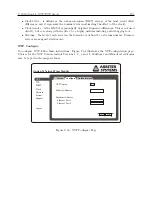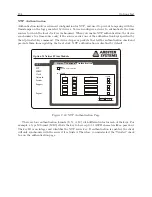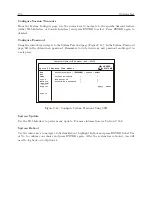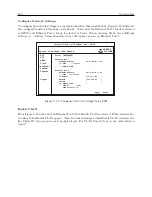
C.19 Option 34: NTP/PTP Server
191
PTP Configuration
To configure PTP follow these instructions. Figure C.36 illustrates the PTP configuration page.
Choices for the Delay Mechanism include either P2P (Peer to Peer) or E2E (End to End). Protocol
choices include UDP IPv4, UDP IPv6 or Layer 2. Figure C.36 shows the Advanced settings, which
can be hidden using the Hide Advanced button.
Option 34 Network Time Module
Status
Configure
NTP
SNMP
Clock
Network
System
Support
Logout
PTP
Enable PTP Service
Apply
Reset
Domain Number
Announce Interval
Sync Interval
Min Delay Request
Min Peer Delay Request
Announce Receipt Timeout
Delay Mechanism
Protocol
Clock Class
Clock Accuracy
Priority 1
Priority 2
0
2
2
2
2
3
P2P
UDP IPv4
6
20
10
128
Hide Advanced
seconds
seconds
seconds
seconds
Figure C.36: PTP Configuration Page
PTP Terms
•
Domain – a collection of one or more PTP subdomains. A subdomain is a logical grouping
of 1588 clocks that synchronize to each other using the PTP protocol, but that are not
necessarily synchronized to PTP clocks in another PTP subdomain. Subdomains provide
a way of implementing disjoint sets of clocks, sharing a common network, but maintaining
independent synchronization within each set.
•
Announce interval – specifies the time for sending announce messages. The range is from 0
to 4 seconds; the default is 2 seconds.
•
Sync interval – the time for sending synchronization messages. The range is from -1 to 1
seconds; the default is 1 second.
•
Delay request interval – specifies the time recommended to the member devices to send delay
request messages when the port is in the master state. The range is -1 second to 6 seconds.
The default is 5 (32 seconds).
Summary of Contents for 1084A
Page 4: ...iv ...
Page 6: ...vi ...
Page 18: ...xviii LIST OF FIGURES ...
Page 24: ...4 Unpacking the Clock ...
Page 36: ...16 Connecting Inlet Power Input and Output Signals ...
Page 44: ...24 GPS Antenna and Cable Information ...
Page 114: ...94 Startup and Basic Operation ...
Page 123: ...B 4 Physical Dimensions 103 Figure B 1 Suggested Mounting of the AS0094500 Surge Arrester ...
Page 124: ...104 Using Surge Arresters ...
Page 134: ...114 Options List C 6 2 Option 06 Firmware Setup Figure C 3 Option 06 Firmware Setup ...
Page 142: ...122 Options List Figure C 5 Option 06 Output Jumper Settings ...
Page 158: ...138 Options List Figure C 13 Option 17 Board Layout and Jumper Locations ...
Page 163: ...C 13 Option 20A Four Fiber Optic Outputs 143 Figure C 14 Option 20A Jumper Locations ...
Page 170: ...150 Options List Figure C 16 Option 23 Internal Jumper Setup ...
Page 172: ...152 Options List Figure C 17 Option 27 Jumper Locations ...
Page 190: ...170 Options List Figure C 20 Option 29 Connector Signal Locations ...
Page 246: ...226 Options List ...
















































